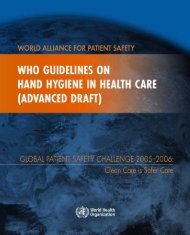Adverse event reporting.pdf
Adverse event reporting.pdf
Adverse event reporting.pdf
Create successful ePaper yourself
Turn your PDF publications into a flip-book with our unique Google optimized e-Paper software.
operators do not practice basic skills, so workers lose skills in exactly the activities<br />
they need in order to take over when something goes wrong.<br />
Automation makes systems more “opaque” to people who manage, maintain, and<br />
operate them. 45 Processes that are automated are less visible because machines<br />
intervene between the person and the task. For example, automation means that<br />
people have less hands-on contact with processes and are elevated to more supervisory<br />
and planning tasks. Direct information is filtered through a machine (e.g., a<br />
computer), and operators run the risk of having too much information to interpret or<br />
of not getting the right information.<br />
In the case study, the infusion device administered the medication and the professional<br />
monitored the process, intervening when problems arose. The medication administration<br />
process was “opaque” in that the device provided no feedback to the user when<br />
the medication flowed freely and minimal feedback when the medication flow was<br />
blocked.<br />
One of the advantages of technology is that it can enhance human performance<br />
to the extent that the human plus technology is more powerful than either is alone. 46<br />
Good machines can question the actions of operators, offer advice, and examine a<br />
range of alternative possibilities that humans cannot possibly remember. In medicine,<br />
automated order entry systems or decision support systems have this aim. However,<br />
technology can also create new demands on operators. For example, a new piece<br />
of equipment may provide more precise measurements, but also demand better<br />
precision from the operator for the equipment to work properly. 47 Devices that have<br />
not been standardized, or that work and look differently, increase the likelihood of<br />
operator errors. Equipment may not be designed using human factors principles to<br />
account for the human–machine interface. 48<br />
In the case study, safer systems could have been designed by taking into consideration<br />
characteristics of how people use machines and interact with each other in teams.<br />
For example:<br />
• Redesign the devices to default to a safe mode<br />
• Reduce the difficulties of using multiple devices simultaneously<br />
• Minimize the variety of equipment models purchased<br />
• Implement clear procedures for checking equipment, supplies, etc., prior to beginning<br />
surgery<br />
• Orient and train new staff with the team(s) with which they will work<br />
• Provide a supportive environment for identifying and communicating about errors for<br />
organizational learning and change to pr<strong>event</strong> errors.<br />
Technology also has to be recognized as a “member” of the work team. When<br />
technology shifts workloads, it also shifts the interactions between team members.
















